#carnivorous caterpillar
Text
4 notes
·
View notes
Text
Just asked my cousin what kind of bug I would be.
No hesitation said "A Hawaiian carnivorous caterpillar"
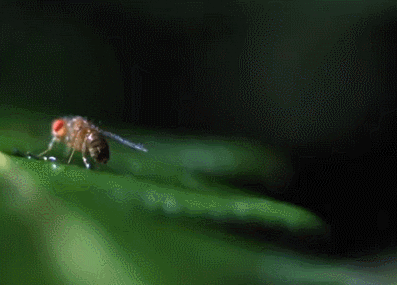
I'm one of these things now
#am i a moth?#does this make me a moth?#what does this mean for my character.#hawaiian carnivorous caterpillar#carnivorous caterpillar#bugs
0 notes
Text
This is so cool.
Tell me you've never wanted a molting cicada plushie. It's got iridescent wings. LOOK AT IT.
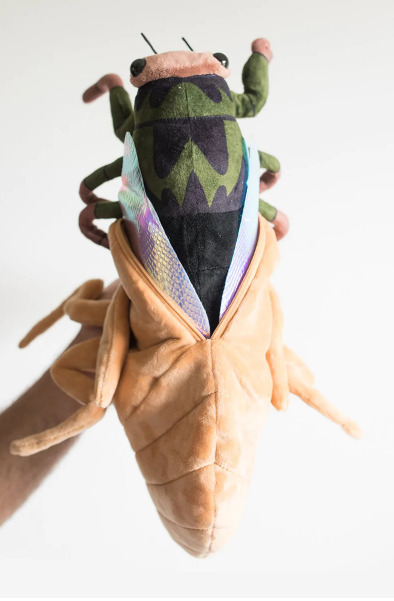
Also got a pitcher plant backpack...with a doomed caterpillar. Sorely tempted.

(he also makes glow in the dark plants) (and breeds monstera) (and has a free downloadable guide to plant breeding for cool characteristics)
anyway support independent artists or something? that make cool things?
#art#bugs#plants#insects#invertabrates#cicadas#pitcher plant#caterpillars#carnivorous plants#vegetarian bugs
12K notes
·
View notes
Text
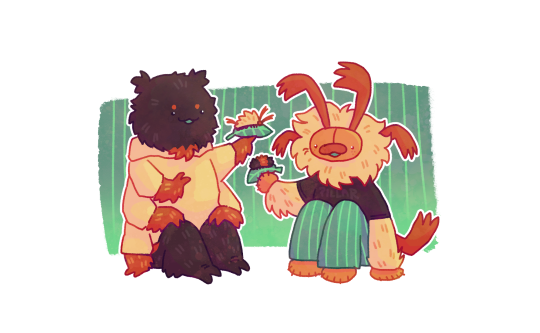



Even more artfights!
Gibby (and Bug) for vehemourn - Plant Pals for StarFilledRam
Skittles for Gay-Air-Conditioner - Frig for lochnessmoron
#my art#artfight#bugsona#my characters#bug#insect#olm#manatee#snake#carnivorous plants#salamander#amphibian#caterpillar
33 notes
·
View notes
Text
shoutout to Feniseca tarquinius for being North America's only butterfly species with carnivorous caterpillars, which sometimes wear the corpses of their prey as camouflage.
the adults don't drink nectar, but do feed on honeydew and drink from mud, dung, and apparently carrion
#thoughts#🍬 post#butterflies#lycaenidae#these guys are a species of harvester and that's the lycaenid subfamily I'm least familiar with but I decided to learn a bit more about the#and apparently they all have carnivorous caterpillars which is really interesting#but this is the only harvester species in North America#also the adults drinking from mud and dung isn't that weird for butterflies. some species will also drink blood if it's readily available#but the fact that it doesn't drink nectar is unusual and I'm fascinated by it just not feeding on plants#oh also the caterpillars only have 4 instars instead of 5 and basically speedrun the larval stage by the sound of it#I can already tell this is gonna be one of my blorbo species just because it's such a little weirdo#I need to start learning to ID harvesters I guess
4 notes
·
View notes
Note
buge
🐛
OH. BUGE
4 notes
·
View notes
Text
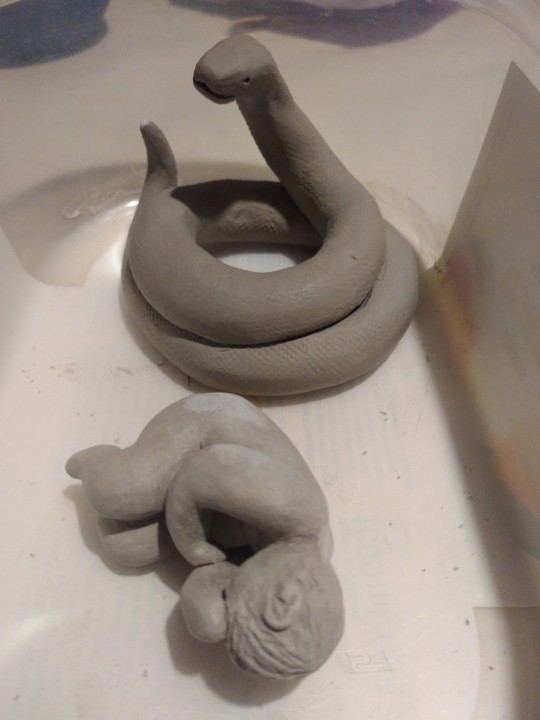

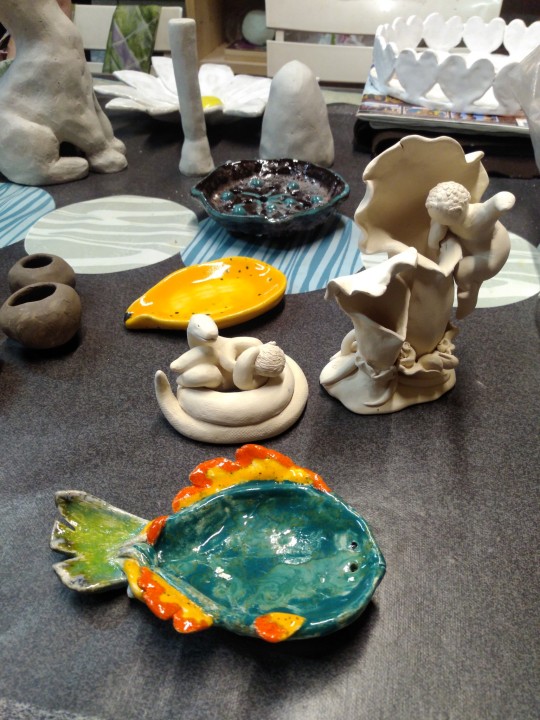
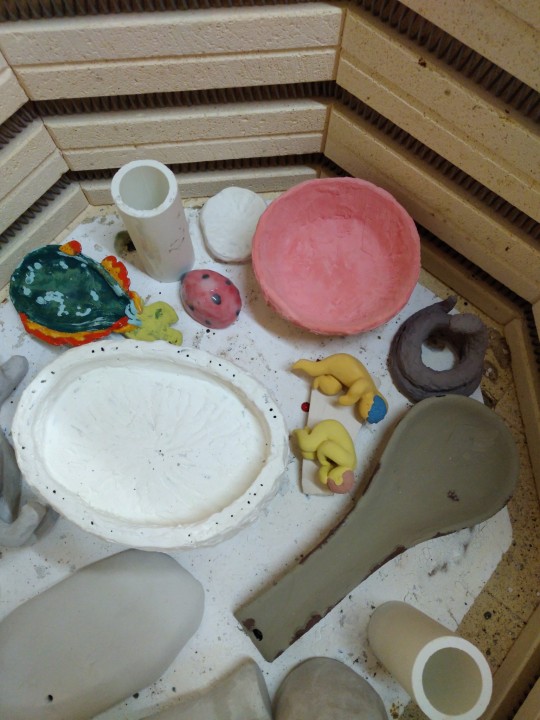
i realize now i haven't updated you in a while so here's what i'm finishing to work on
#i got really obsessed with this baby series out of nowhere#i still have another one i need to do#riding a caterpillar#i always mess it all up when it comes to enamel them tho#it's really funny how everyone makes kitchenware and stuff and i keep making shit i have no idea where to put in my house#who wants to buy from me ✨🌸#i wanted to make the snake scarier (on the outside only yes a tsundere snake) but it dried up before i could#i yeah i also want to make giant carnivorous moth preying on a baby picking berries#mine#modelage
2 notes
·
View notes
Text
Not only is my mini rose actually alive still after I put it outside, but it's also hosting a whole bunch of bugs ☺️💕
#i would however like the roses to survive being hosted... i see what looks like a tussock caterpillar which i know can eat oak#so i could transfer that off; i see a ladybug larva and those are carnivorous so that's good to go#there's 3 other caterpillars i dont quite recognize! 2 look like smaller instar tussocks but there's a big green one im not sure about#might clean out my bug tank today and transfer over the ones that seem to be tussock moths and give them some oak and see#if they eat; one of the rosebuds has been completely decimated and I'd like to try to save the other one kdjfkffk#i want my roses to live!! genuinely thought I'd killed them but once they were outside they seemed to do a lot better#in spite of the heat... anyways i got TWO (2) butterfly enclosures for christmas and I'll place one over the plant#no one comes in and no one leaves and we'll try to take it from there#very interested to see what develops from the unknown larvae!!#hoatm rants
2 notes
·
View notes
Text
vampires are not undead but instead a type of creature similar to a harvester butterfly. vampires as we know them are the larvae and humans are their host species which they feed on. but once they've had their fill they will transform into something beyond our comprehension
1 note
·
View note
Text
I love insects where the juveniles eat meat and the adults drink nectar. Wasps with huge wicked sharp jaws and venomous stingers all to carry some spider back to its nest for its big soft wriggly babies to eat. She's going to go lazily drink nectar while they really go to town on it. So many fly larvae are voracious carnivores to be feared and avoided and then they turn into dopey flies that wander from flower to flower only stopping to lay eggs conspicuously close to a bunch of caterpillar eggs.
15K notes
·
View notes
Text


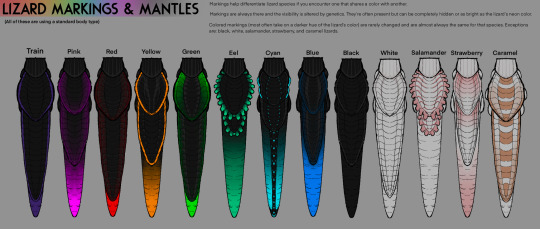

Finally got around to finishing this houugh... it was a lot of work but I really like the end result!! Naturally, I'll try my best to list some of the thoughts I have in mind for these guys below. Long post ahead!
These lizards are intended to be ALMOST fully arthropod-like but due to my lack of understanding of bug anatomy and creative liberties, they are in that gray spec bio area so don't take any inconsistencies too seriously (or rather, fuck logic, and accept them how I describe them regardless)
Inspirations:
- my lesser detailed lizard design
- my friend's slugcats
- wasps for the head contours, various insects for the exoskeleton guidelines, caterpillars, various stylistic slugcats across the #rainworld tag
- the burning need for something more detailed and cool in my drawing vocabulary
The actual meat of the post; extra facts:
- Lizards are related to slugcats (in my au, if you wanna call it that?) or at least the very early version of them. This idea is borrowed from this post and in my au, lizards evolve a similar tail to a slugcat's to aid in propelling themselves through tight spaces, acting as a 5th limb.
- Similar to my old vulture post, lizards share a similar lifecycle. The majority of the larval stage is spent underground and in tight spots, far from their main predator. Lizard larva will undergo pupation similar to how beetles do, leaving behind broken cavities in pipes where carnivorous plants favor to take root. Additionally to the vulture's terrible parental drive, they often mistake their own larva for lizard hatchlings.
- A lizard's skin is leathery and retains moisture for quite a while. Some lizards have a thicker layered mantle than others, allowing them to take punctures to the abdomen and still recover.
- Not pictured, but will be described, are a few outliers to the standard lizard body plan. Caramels have muscular hind legs akin to a grasshopper but this means their legs cannot slot together and thus they have a wider leg splay than other species. Eels and salamanders are not lizards but lizard mimics. Yellow lizards' antennae attach to a hump on the snout rather than the rear of the head as seen here. Cyan lizards' mantles are more square shaped due to their leap drums on either side of their bodies and have a 3rd mantle that runs the length of their tail and caps the tailtip.
- Cyan lizard's organs are called leap drums and act similarly to our lungs. They are a ring of muscle which contracts and acts as a spring loaded mechanism to propel the creature via combustion through a mysterious chemical process. Because the color of debris left behind during a leap share the same color as the lizard, perhaps they are discarded scales, formerly in place to protect the cavities housing the explosion.
- They have similar organs to vertebrates within their abdomen, probably surrounded by cartilage. (not that important, I haven't thought that much about this)
- (More may be added later as I remember)
#myart#rainworld#rainworld lizard#rain world lizard#rw lizard#bug#insect#bugs#insects#rainworldbuilding
2K notes
·
View notes
Text
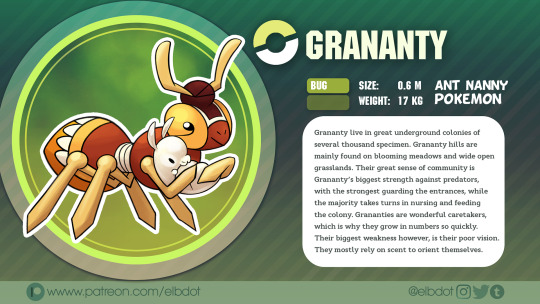



NOW for a VERY unusual set of Fakemon, I present you
Grananty and the predatory line of Eeriedescent - based on a real butterfly species and its unusual life cycle:
The Large Blue (Phengaris arion)
It's worth reading through all the Pokedex Entries one by one for this! And then go check out this video fully illustrating the life of one of Britains rarest butterflies :D
youtube
While I fully embrace the dark undertones of the Large Blue with its carnivorous caterpillar in my Fakemon designs, it's worth noting that this is in fact one of my favorite butterfly species for requiring SO many unique factors and circumstances to succeed in its evolution and I don't mean to demonize it!
Parasitic species the like are an important factor in keeping an ecosystem balanced and stable by preventing overpopulation of certain other species, so please don't grow resentful towards the Large Blue, but rather embrace the unusual butterfly for the macabre yet fascinating role it plays in nature :D
If you want to support my work, you can check out my
Patreon!
#large blue#fakemon#pokemon#butterfly#butterfly conservation#insects#bugs#ants#ant#my art#elbdot art#elbdot
776 notes
·
View notes
Text
man ants literally are the creatures with the most cosmic horror happening to them on a day to day basis. carnivorous caterpillars that brainwash them into making it their larva eating queen that tree that mind controls them into protecting it via dispersal of honeydew literally everything to do with cordyceps. ants are nature's most tormented little guys
177 notes
·
View notes
Text
December 12th, 2023
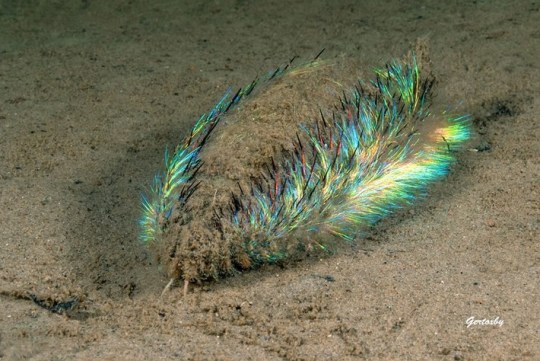

Sea Mouse (Aphrodita aculeata)
Distribution: Found in marine habitats of the northern hemisphere; the North Atlantic, North Sea, Baltic Sea and the Mediterranean Sea.
Habitat: Benthic; lives from the sublittoral zone down to a maximum of 1000 metres.
Diet: Carnivorous; feeds mainly on other invertebrates such as small crabs, hermit crabs, mollusks, nemerteans and other polychaete worms.
Description: Despite its caterpillar-like appearance, the sea mouse is actually a polychaete worm! Its most obvious feature is the dense mat of hairs, or setae, that cover its body. While most are a brownish-red colour, these are intermingled with glassy hairs (especially on either side of its body), which have an iridescent quality. These hairs are usually reddish in colour, but become a bright bluish-green when the light hits them a certain way. This acts as a defence mechanism to ward off predators, acting as a form of aposematism, but also acts as camouflage, with the worms appearing brown from above (blending in with the substrate) and blue from the sides (blending in with the water).
(Images by Gert Oxby and Michel Garnier)
160 notes
·
View notes
Note
Sorry if youve answered this before, but how do you chose the bugs to assign to each character ? Also they are all really cool and fun :3
Hi, I’ve explained this before but I’ll do it again! Last time I explained it was less specific to the character and more to the caste, so this’ll be a little different. I use the metaphors and associations of the insect to pick their species as well as their diet. I’m calling the species a troll mimics their ‘morph’.
Aradia: Fly. Associated with death. Detritivore.
Tavros: Craneflies. Frailty, timidness, clumsiness. Thinking longhorn beetle might be a funnier pun though, so I might change it. Herbivore.
Sollux: Bees. Construction, intelligence, connections to groupthink/hiveminds/psi. Herbivore.
Nepeta: Caterpillar. It’s a pun. Herbivore.
Karkat: Isopod. Highly social insect. Durable shell representing defensiveness/personal barriers, but also serving literal aspect of ‘thick skin.’ Detritivore.
Kanaya: Hornet. Dangerous but caring parents, association with femininity. Omnivore.
Terezi: Dragonfly. Good eyesight’s associated with clarity, though large eyes would also be easier to blind. Good at flying. Dragon pun. Carnivore.
Vriska: Spider. Manipulative, association with femininity. Carnivore.
Equius: Beetle. Strong. Omnivore.
Gamzee: Praying mantis. Associations with religion due to unique praying pose. Carnivore.
Eridan: Anolomacaris. Extinct skilled distance hunter. Carnivore.
Feferi: Trilobite. Large curved spines, trident tongue, ‘ruler of precambrian seas.’ Detritvore.
All insects before Jade are herbivores or detritivores, and all insects jade and after are middle to highblood can hunt. This was to set up an intentionally antagonistic relationship between lowbloods and highbloods. It’s also a new way to play with themes in my personal work which are all about animal dynamics.
I mostly did the human kids as bugs as a joke, because they’re not aliens at all so its funny!! But I had a ton of fun with them so here we go again. I chose them off colors and gimmicks.
John: Spitbug. They’re bright green and gooey boys. Like ectoplasm. Rose: Rosy maple moth. Name association—also bright pink and yellow against their will. Rose wishes she was a cool goth all-black moth. Moths are associated with ‘seeking light.’
Dave: Assassin beetle/wheel bug. Have a gear shaped bump on back, large black eyes, efficient predators, some red coloration. Fits in with his expectations and pressures.
Jade: Wooly aphid. They’re white, fuzzy, with rainbow wings. That’s so her.
Jane: Candy-striped leafhopper. Bright cyan with red highlights, food-themed name.Roxy: Pink-spotted cattleheart. Gorgeous pink and black coloring. Butterflies are nectar-drinkers, associated with celebration and inebriation. Kinda clumsy too.
Dirk: Tiger beetle. They can move in bursts of motion faster than they can see. That’s flash stepping. Orange and black.
Jake: Diving beetle. Dark green with orange highlights, explorers who go where other beetles cannot.
57 notes
·
View notes
Text
The Salii’Qi - Saliinthia’s Sophonts
The primary sophont species residing on the warm, Earth-like world of Saliinthia are the Salii’Qi, a race of strange mammalian-insect creatures. They have dispersed into four main subspecies, two sedentary groups who live in the forests and islands respectively, and the two nomadic groups who call the grasslands and deserts home. Through this blog I will delve deep into their various cultures, religions, technology, and day to day lives living on Saliinthia!
Basic Biology
The Salii’Qi evolved from intelligent, largely carnivorous pack hunters, with the grassland subspecies being the oldest ones. They have intelligence equivalent to that of human beings, though tending to be better at problem solving. Their mammal-like biology gives them warm blood and dense bones, though their skeleton is derived from a graphite filled exoskeleton similar to that of insects, that was slowly internalized over the course of millions of years. They are egg layers, and have a complex life cycle not unlike that of an Earth caterpillar or beetle.
Salii’Qi have three sets of eyes, two are simple and detect movement and light only, while the third pair is complex and has an expanding and contracting pupil like Earth’s vertebrates. They hear through bright colored ear flaps held up by cartilage, able to swivel and pin to show emotion or focus in on certain sounds.
Salli’Qi have four pairs of limbs, two are used for walking while the other two are used for physical manipulation. One pair of limbs are attached to the skull. These “arms” evolved from pedipalps, now used for eating and handling weapons or other objects. The pedipalps are weaker than their forearms, so they usually use those for heavier work like lifting large objects. With the evolution of centaurism in these creatures, they lost a lot of flexibility in their backs, and so can no longer keep their forearms on the ground for long periods of time.

The skeleton of the Salii’Qi have a dark color due to the high amount of graphite present in their bones, with black teeth stronger than ours. Their bones are dense and very similar to ours, although the ribs are free floating and connected with cartilage. Some of the vertebrae located near the end of the body are fused, which aid in supporting the back. Ancient relatives had a connected skeleton below the skin, which resembled that of insects. To allow for more flexibility and dexterity, those bones have now been reduced to cover less area.

Salii’Qi have organs very similar to ours, but have a unidirectional respiratory system. They breathe in through two spiracles beneath their eyes, and after passing through the lungs, it is exhaled through the two spiracles placed behind the first pair of leg’s shoulders. This allows faster replacement of oxygen in the bloodstream, fueling their insect-like biology.
Their digestive system extremely similar to ours, the only notable difference being the tiered stomach, which allows for tough protein rich plant matter to be digested.
Salii’Qi have a gonochoric reproductive system, meaning they have two sexes. Both sexes have bright colored ear flaps and antennae, but during the spring the male coloration deepens for mating. Females are slightly larger than males, and have duller colors. Depending on the culture, females may take multiple male partners during the mating season, or only keep one partner for their whole life.
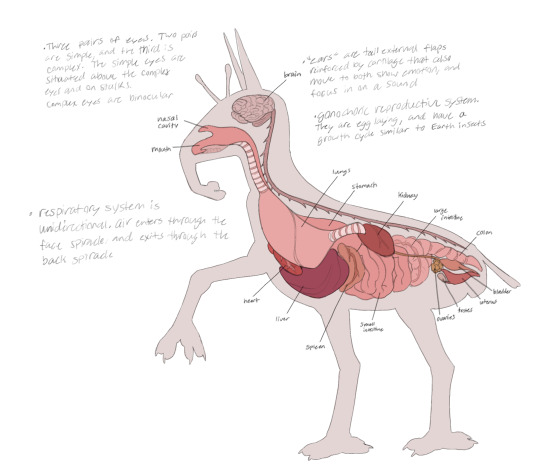
Subspecies
The Salii’Qi are spread over four main subspecies, and are regional variants. As mentioned before, the nomadic grasslanders were the first successful variants, which then radiated into the forest, desert, and island subspecies. As the names imply, they live in settlements and groups around specific biomes they are best adapted to.

The foresters are mostly a sedentary group, and also physically the largest. They eat the most fruit and plant matter out of any other , and have learned how to farm and selectively breed crops. They have long, thin limbs for reaching up into the vegetation, and upturned simple eyes to see differences in the shadows above. They are skittish and try too keep to themselves, but enjoy trading their crops with other groups.
Grasslanders are nomadic, but have specific areas they return to during nesting season. They follow the herds of large grazers who roam the grasslands, using their good stamina to their advantage. They are a proud and strong group, seen as kind and humorous. They are artisans, creating unique goods and clothing out of hides and pelts for trading with other groups.
Desert dwellers live in smaller groups, and instead of hunting, they primarily ranch and travel with herds of domesticated livestock. Desert Salii'Qi forage desert fruits, roots, and other plant matter before a harvest. They travel to feeding grounds during the fall and winter, but return to fertile river communities during the spring and summer where plants for livestock flourish along the banks. During this time, the desert Salii-Qi raise their children to take on their next journey.
Islanders are small, social Salii'Qi who settled on an archipelago millions of years ago. They are the most well adapted group and the second oldest subspecies. Islanders have partially webbed feet, seal-like fur, powerful limbs, and higher back spiracles which makes it easier to spend time in the water. They primarily feed on fish and island fruit which they've selectively bred. Islanders mainly spearfish, but also use boats for fishing and trade. They routinely voyage to the mainland to trade goods, and some have even settled on the mainland shores.
#salii'qi#saliinthia#spec bio#speculative biology#biology#xenobiology#alien#speculative fiction#speculative ecology#aliens#sci fi#evolution
199 notes
·
View notes